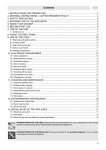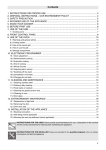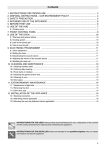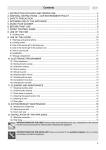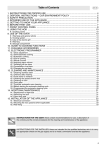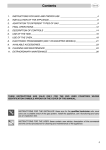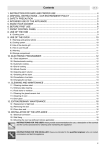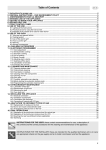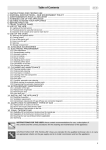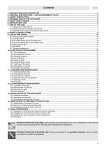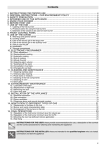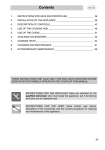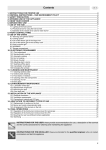Download Smeg SUK61CPX5 cooker
Transcript
Table of Contents 1. INSTRUCTIONS FOR PROPER USE ..................................................................................... 4 2. DISPOSAL INSTRUCTIONS – OUR ENVIRONMENT POLICY ............................................. 5 3. SAFETY PRECAUTION .......................................................................................................... 6 4. INTENDED USE OF THE APPLIANCE ................................................................................... 6 5. GETTING TO KNOW YOUR APPLIANCE .............................................................................. 7 6. BEFORE FIRST USE .............................................................................................................. 7 7. FRONT CONTROL PANEL ..................................................................................................... 8 8. USE OF THE HOB ................................................................................................................ 10 8.1 Cooking zone ................................................................................................................................................ 10 9. USE OF THE OVEN .............................................................................................................. 11 9.1 Warnings and general advice ........................................................................................................................ 11 9.2 Cooling system .............................................................................................................................................. 11 9.3 Use of the electric grill ................................................................................................................................... 11 9.4 How to use the grill ........................................................................................................................................ 12 9.5 Warning ......................................................................................................................................................... 12 9.6 Storage compartment ................................................................................................................................... 12 10. AVAILABLE ACCESSORIES .............................................................................................. 13 11. ELECTRONIC PROGRAMMER ......................................................................................... 14 11.1 Clock adjustment ......................................................................................................................................... 14 11.2 Semiautomatic cooking ............................................................................................................................... 14 11.3 Automatic cooking ....................................................................................................................................... 14 11.4 End of cooking ............................................................................................................................................ 14 11.5 Minute Counter ............................................................................................................................................ 15 11.6 Adjusting alarm volume ............................................................................................................................... 15 11.7 Switching off the alarm ................................................................................................................................ 15 11.8 Cancellation of set data ............................................................................................................................... 15 11.9 Changing the set data ................................................................................................................................. 15 12. CLEANING AND MAINTENANCE ....................................................................................... 16 12.1 Cleaning stainless steel .............................................................................................................................. 16 12.2 Ordinary daily cleaning ............................................................................................................................... 16 12.3 Food stains or residues ............................................................................................................................... 16 12.4 Cleaning the glazed ceramic hob ................................................................................................................ 16 12.5 Cleaning of oven ......................................................................................................................................... 17 12.6 Door glass ................................................................................................................................................... 17 12.7 Pyrolysis: automatic oven cleaning ............................................................................................................. 17 12.8 Before starting the automatic cleaning cycle .............................................................................................. 17 12.9 Programming the automatic cleaning cycle ................................................................................................ 18 13. EXTRAORDINARY MAINTENANCE ................................................................................... 19 13.1 Replacement of light bulb ............................................................................................................................ 19 13.2 Removing the door ...................................................................................................................................... 19 13.3 Oven door joint ............................................................................................................................................ 19 14. INSTALLATION OF THE APPLIANCE ................................................................................ 20 14.1 Electrical connection ................................................................................................................................... 20 14.2 Mounting the rear top skirtboard (where applicable) ................................................................................... 21 14.3 Wall fixing .................................................................................................................................................... 21 INSTRUCTIONS FOR THE USER: these contain recommendations for use, a description of the controls and the correct procedures for the cleaning and maintenance of the appliance. INSTRUCTIONS FOR THE INSTALLER: these are intended for the qualified technician who is to carry out appropriate checks on the gas supply and is to install, commission and test the appliance. 3 Precautions for use 1. INSTRUCTIONS FOR PROPER USE THIS MANUAL IS AN INTEGRAL PART OF THE APPLIANCE AND THEREFORE MUST BE KEPT IN ITS ENTIRETY AND IN AN ACCESSIBLE PLACE FOR THE WHOLE WORKING LIFE OF THE COOKER. WE ADVISE READING THIS MANUAL AND ALL THE INSTRUCTIONS THEREIN BEFORE USING THE COOKER. ALSO KEEP THE SERIES OF NOZZLES SUPPLIED. INSTALLATION MUST BE CARRIED OUT BY QUALIFIED PERSONNEL IN ACCORDANCE WITH THE REGULATIONS IN FORCE. THIS APPLIANCE IS INTENDED FOR DOMESTIC USES AND CONFORMS TO CURRENT REGULATIONS IN FORCE. THE APPLIANCE HAS BEEN BUILT TO CARRY OUT THE FOLLOWING FUNCTIONS: COOKING AND HEATING-UP OF FOOD. ALL OTHER USES ARE CONSIDERED IMPROPER. THE MANUFACTURER DECLINES ALL RESPONSIBILITY FOR IMPROPER USE. NEVER USE THIS APPLIANCE FOR HEATING ROOMS. DO NOT LEAVE THE PACKING IN THE HOME ENVIRONMENT. SEPARATE THE VARIOUS WASTE MATERIALS AND TAKE THEM TO THE NEAREST SPECIAL GARBAGE COLLECTION CENTRE. THIS APPLIANCE IS MARKED ACCORDING TO THE EUROPEAN DIRECTIVE 2002/96/EC ON WASTE ELECTRICAL AND ELECTRONIC EQUIPMENT (WEEE). THIS GUIDELINE IS THE FRAME OF A EUROPEAN-WIDE VALIDITY OF RETURN AND RECYCLING ON WASTE ELECTRICAL AND ELECTRONIC EQUIPMENT. DO NOT OBSTRUCT VENTILATION OPENINGS AND HEAT DISPERSAL SLITS. THE I.D. PLATE WITH TECHNICAL DATA, REGISTRATION NUMBER AND BRAND NAME IS VISIBLY POSITIONED IN THE STORAGE COMPARTMENT. THE PLATE MUST NOT BE REMOVED. BEFORE THE APPLIANCE IS PUT INTO OPERATION, ALL THE LABELS AND PROTECTIVE FILMS APPLIED INSIDE OR OUTSIDE MUST BE REMOVED. DO NOT USE METALLIC SPONGES OR SHARP SCRAPERS: THEY WILL DAMAGE THE SURFACE. USE NORMAL NON-ABRASIVE PRODUCTS FOR STEEL, AND A WOODEN OR PLASTIC TOOL IF NECESSARY. RINSE THOROUGHLY AND DRY WITH A SOFT CLOTH OR DEERSKIN. DO NOT ALLOW RESIDUES OF SUGARY FOODS (SUCH AS JAM) TO SET INSIDE THE OVEN. IF LEFT TO SET FOR TOO LONG, THEY MIGHT DAMAGE THE ENAMEL LINING OF THE OVEN. The manufacturer declines all responsibility for damage to persons or things caused by nonobservance of the above prescriptions or by interference with any part of the appliance or by the use of non-original spares. 4 Our environment policy - Disposal instructions 2. DISPOSAL INSTRUCTIONS – OUR ENVIRONMENT POLICY Our appliances are only packaged using non-pollutant, environment-friendly, recyclable materials. We urge you to cooperate by disposing of the packaging properly. Contact your local dealer or the competent local organisations for the addresses of collection, recycling and disposal facilities. Never leave all or part of the packaging lying around. Packaging parts, and especially plastic bags, may represent a suffocation hazard for children. Your old appliance must also be disposed of properly. Important deliver the appliance to your local organisation authorised to collect scrapped appliances. Proper disposal allows the intelligent recovery of valuable materials. Refrigeration appliances contain gases which may damage the environment; it is important to ensure that the refrigeration circuit pipelines are not damaged until the competent service has taken delivery of the appliance. Before scrapping your appliances it is important to remove doors and leave shelves in position as for use, to ensure that children cannot accidentally become trapped inside during play. Also, cut the power supply lead and remove it and the plug. 5 Safety Precautions 3. SAFETY PRECAUTION ELECTRICAL CONNECTION: PLEASE REFER TO INSTALLATION INSTRUCTION FOR THE GAS & ELECTRICAL SAFETY REGULATIONS AND THE VENTILATION REQUIREMENTS. IN YOUR OWN INTEREST, AND THAT OF SAFETY, IT IS THE LAW THAT ALL GAS APPLIANCES BE INSTALLED AND SERVICE BY COMPETENT PERSONS, WHO WILL COMPLY WITH THE RELEVANT STANDARDS AND REGULATIONS. CORGI REGISTERED INSTALLERS UNDERTAKE TO WORK TO SATISFCTIORY STANDARDS. DISCONNECTION OF GAS AND ELECTRIC APPLIANCES SHOULD ALWAYS BE CARRIED OUT BY COMPETENT PERSON. THE PLUG TO BE CONNECTED TO THE POWER CABLE AND THE SOCKET MUST BE THE SAME TYPE AND MUST CONFORM TO CURRENT REGULATIONS. THE SOCKET MUST BE ACCESSIBLE AFTER THE APPLIANCE HAS BEEN BUILT IN. NEVER UNPLUG BY PULLING ON THE CABLE. DO NOT INSTALL THIS APPLIANCE ON A RAISED PLATFORM. IT IS COMPULSORY THAT THE APPLIANCE BE GROUNDED ACCORDING TO THE METHODS REQUIRED BY SAFETY RULES. IMMEDIATELY AFTER INSTALLATION CARRY OUT A BRIEF INSPECTION TEST OF THE APPLIANCE, FOLLOWING THE INSTRUCTIONS BELOW. SHOULD THE APPLIANCE NOT FUNCTION, DISCONNECT IT FROM THE SUPPLY AND CALL THE NEAREST TECHNICAL ASSISTANCE CENTRE. NEVER ATTEMPT TO REPAIR THE APPLIANCE. DO NOT PUT PANS WITHOUT PERFECTLY SMOOTH AND FLAT BOTTOMS ON THE HOB GRIDS. ATTENTION: IN CASE OF A CRACK BEING DETECTED IN THE GLAZED CERAMIC HOB, IMMEDIATELY DISCONNECT FROM MAINS AND CONTACT THE NEAREST SERVICING CENTRE. NEVER PUT INFLAMMABLE OBJECTS IN THE OVEN: THEY COULD BE ACCIDENTALLY LIGHTED AND CAUSE FIRES. DURING USE THE APPLIANCE BECOMES VERY HOT. TAKE CARE NOT TO TOUCH THE HEATING ELEMENTS INSIDE THE OVEN. THE APPLIANCE IS DESIGNED FOR USE BY ADULTS. DO NOT ALLOW CHILDREN TO GO NEAR OR PLAY WITH IT. WHEN OPERATING THE GRILL ALL ACCESSIBLE PARTS COULD BECOME VERY HOT: KEEP OUT OF THE WAY OF CHILDREN. WHEN NOT IN USE, MAKE SURE THAT THE CONTROL KNOBS ARE IN THE CORRECT (OFF) POSITION 0. 4. INTENDED USE OF THE APPLIANCE THE APPLIANCE HAS BEEN BUILT TO CARRY OUT THE FOLLOWING FUNCTIONS: COOKING AND HEATING-UP OF FOOD. ALL OTHER USES ARE CONSIDERED IMPROPER. The manufacturer declines all responsibility for damage to persons or things caused by nonobservance of the above prescriptions or by interference with any part of the appliance or by the use of non-original spares. 6 Instructions for the user 5. GETTING TO KNOW YOUR APPLIANCE CONTROL PANEL OVEN COMPARTMENT OVEN FAN OVEN LIGHT OVEN DOOR OVEN DOOR HANDLE OVEN GUIDE FOR SHELF AND PAN 6. BEFORE FIRST USE Do not leave the packing in the home environment. separate the various waste materials and take them to the nearest special garbage collection centre. The inside of the appliance should be cleaned to remove all manufacturing residues. For further information about cleaning, see section "12. CLEANING AND MAINTENANCE" Using the oven and the grill for the first time, heat them to the maximum temperature for as long as it takes to burn off any production oil residues which could give a nasty flavour to the food. After a power cut, the oven display will flash intermittently and show ELECTRONIC PROGRAMMER” . To adjust refer to paragraph "11. 7 Instructions for the user 7. FRONT CONTROL PANEL All the cooker controls and commands are on the front panel. OVEN THERMOSTAT KNOB FRONT LEFT-HAND COOKING ZONE OVEN FUNCTION KNOB REAR LEFT-HAND COOKING ZONE VARIABLE GRILL REAR RIGHT-HAND COOKING ZONE FRONT RIGHT-HAND COOKING ZONE Before using the oven make sure that the symbol ELECTRONIC PROGRAMMER”. ; appears on the display. See paragraph “11. COOKING HOB CONTROL KNOB Standard heating The circle next to each knob indicates the cooking zone it controls. To heat, push and turn the knob to the desired position. Adjustment is continuous so that the appliance also operates at any intermediate value. To turn off, return the knob to Double heating The circle next to each knob indicates the cooking zone it controls. To heat the inner cooking zone, push and turn the knob to the desired position. To heat both the inner and outer cooking zones, turn the knob to / ; and then release. The knob will thus return to 9. To adjust heating intensity, rotate the knob anticlockwise to the desired position . To return to heating of the inner cooking zone only, set the knob back to and then turn to the desired position. To switch off, return knob to . OVEN THERMOSTAT KNOB Selection of cooking temperature is carried out by turning the knob clockwise to the required temperature, between 50° and 275°C. If the appliance has an electric oven, the warning light will come on when the oven is heating up. When it goes out it means that the required temperature has been reached. Regular flashing means that oven temperature is being constantly maintained at the programmed level. 8 Instructions for the user VARIABLE GRILL KNOB Position the oven function knob on the symbol or . Turn the variable grill knob clockwise to the desired position. This allows to vary heat intensity when cooking with the grill. The knob can be set with continuity between “0” and the stop release position, which corresponds to maximum heat. OVEN CONTROL KNOB Each of the functions listed below can be used (except the oven light and the small grill) only together with the correct temperature thermostat regulation as described on page 10 of this manual. TOP AND BOTTOM ELEMENTS GRILL ELEMENT + FAN GRILL ELEMENT BOTTOM ELEMENTS + FAN GRILL ELEMENT + ROTISSERIE FAN HEATING ELEMENT BOTTOM ELEMENTS TOP AND BOTTOM ELEMENTS + FAN HEATING ELEMENT TOP AND BOTTOM ELEMENTS + FAN AUTOMATIC CLEANING CYCLE (PYROLYSIS) DOOR CLOSURE LIGHT Whilst the automatic (Pyrolysis) cleaning cycle is on, this light comes on to indicate that the oven door closure device is active. 9 Instructions for the user 8. USE OF THE HOB 8.1 Cooking zone The appliance features 4/5 cooking zones of different diameter and power. Their position is clearly indicated by circles and the heat given off is defined by the markings on the glass surface. The 5 cooking zones are of the HIGH-LIGHT type and come on after a few seconds of being activated. Heating intensity can be adjusted by means of the knobs located on the front panel from a minimum to a maximum. The cooking zones marked by two concentric circles and by a circle + fish-kettle feature double heating either within the inner circle or both circles. The 4 signal lamps located between the cooking zones come on when the temperature of one or more of the heating zones exceeds 60°C. The lamps go off upon temperature dropping to below approximately 60°C. When using for the first time, it is advisable to heat up the cooking hob to its maximum temperature for enough time so as to burn off any possible oily manufacturing residues, the smell of which could otherwise be absorbed by the food. For best results and energy saving, only use receptacles suitable for electric cooking: • The bottom of the receptacles must be very thick and perfectly flat; before placing on the cooking hob, make sure that it, as well as the cooking hob itself, are perfectly clean and dry. • To avoid scratching of the cooking hob, never use cast-iron receptacles or receptacles with a rough bottom. • To avoid waste of energy, make sure that the diameter of the receptacle bottom is the same as that of the circle marked on the cooking hob. Take care not to spill sugar or sweet mixtures on to the cooking hob when hot. Never place materials or substances which may melt (plastic or aluminium foil) on to the cooking hob. In the event, promptly switch off and remove the molten material with the scraper provided while the top is still warm to prevent it from being damaged. Failure to instantly clean the glazed ceramic hob could lead to encrustations which are impossible to remove once the hob has cooled down. Important. Beware of children in the vicinity as the signal lamps indicating residual heat are out of sight to them. In fact, even after having been turned off, the cooking hob remains hot for a certain period of time. Make sure that children never touch the cooking hob. 10 Instructions for the user 9. USE OF THE OVEN For the models with electronic programmer, before using the oven make sure that the display shows the symbol . During and after use the accessible parts of the oven may be very hot, and children must always be kept at a distance. 9.1 Warnings and general advice Using the oven and the grill for the first time, heat them to the maximum temperature for as long as it takes to burn off any production oil residues which could give a nasty flavour to the food. After a power cut, the oven display will flash intermittently and show . To adjust refer to paragraph "11. ELECTRONIC PROGRAMMER ” Oven accessories which may come into contact with foods are made from materials complying with the requirements of the current directive. During cooking, do not cover the bottom of the oven with aluminium or tin foil and do not place pans or oven trays on it as this may damage the enamel coating. If you wish to use greaseproof paper, place it so that it will not interfere with the hot air circulation inside the oven. To prevent problems caused by steam in the oven, open the door in two stages: half open (5 cm approx.) for 4-5 seconds and then fully open. To access food, always leave the door open as short a time as possible to prevent the temperature in the oven from falling and ruining the food. 9.2 Cooling system The oven is equipped with a cooling system which automatically comes on upon a few minutes after the oven has been turned on. Operation of the fan generates a normal air flow which comes out from the rear of the hob and may continue for a short time even after the oven is turned off. 9.3 Use of the electric grill For short cooking times, for example for browning already-cooked meat, select the static grill function ; set the thermostat knob to maximum temperature and adjust grill intensity by means of the variable grill knob. The ventilated grill function allows actual cooking to be done, thanks to the forced ventilation which lets heat penetrate inside the food. For this type of cooking select the ventilated grill function , set the thermostat knob to the desired cooking temperature (never more than 225°C) and adjust grill intensity by means of the variable grill knob. Cooking time must not exceed 60 minutes. 9.3.1 Operation of the grill + rotisserie Both the static and the fan grill functions can be used for cooking in combination with the rotisserie. Fit the spit rod into the rotisserie bushing, select the static or fan grill function, set the thermostat knob to maximum temperature and adjust grill intensity by means of the variable grill knob, without exceeding the ¾ stroke as shown in the figure. Cooking procedures with grill and rotisserie must never last more than 60 minutes. All cooking procedures with grill + rotisserie must be carried out with the door closed to prevent the knobs and front panel of the appliance from overheating. 11 Instructions for the user Fit the spit roasting rod and tighten screws A of the forks. Slide shelf B onto the third runner from the bottom. Lift handle D and position the rod of the rotisserie so that block E rests guided on support B. Push in support B completely so that the end of the rod enters hole C on the back wall of the oven. Position a tray F on the first runner from the bottom and pour a little water into it to prevent smoke from forming. 9.4 How to use the grill Once the grill is lit, the red warning light will come on. Leave the oven to heat up for five minutes before placing the food inside. Food should be flavoured and basted with oil or melted butter before cooking. An oven dish should be used to contain the sauces. The food should be placed on the oven shelf which is positioned on one of the guides supplied with the different ovens, following the instructions below: FOOD Flat or thin meat GRILLE ON THE SHELF 3 Rolled roast joints 2-3 Poultry 2-3 9.5 Warning • • • • • • • The duration of cooking should not last more than 60 minutes. For models with an electric oven, cooking with the grill and grill + rotisserie must be carried out with the oven door closed. To avoid hazardous overheating when using the oven or the grill, the appliance’s glass lid must always be left open. During and after use of the grill the accessible parts can be very hot; it is therefore necessary to keep children away from the appliance. When cooking with the rotisserie, it is advisable to place one of the trays supplied to collect juices and fats that might form on the bottom of the oven, sliding it into the first runner from the bottom. During cooking, the bottom of the oven should not be covered with aluminium foil and pans or plates should not be rested on it to avoid damaging the layer of enamel. If you wish to use greaseproof paper, position it in such a way that it does not interfere with the circulation of warm air inside the oven. Whilst the oven is in use, remove all of the unused trays and grills from inside the oven.. 9.6 Storage compartment A storage compartment, accessible by pulling on the top edge of the door, is located beneath the oven. Never store inflammable materials such as rags, paper or the like. The compartment is intended only for holding the metal accessories of the range. The inside of the compartment becomes very hot during operationof the oven: turn off the oven and let it cool down before opening the compartment door. 12 Instructions for the user 10.AVAILABLE ACCESSORIES Inside the oven, 4 runners allow the trays and shelves to be positioned at different heights. Oven shelf: used for cooking dishes in trays, small tarts, roasts or dishes that need to be cooked on a fine grille. Tray shelf: to be placed above a tray for cooking dishes that might drip. Drip tray: useful for retrieving fats that have come from dishes resting on the top shelf. Pastry tray: for cooking cakes, pizzas etc. Rotisserie: useful for cooking poultry, sausages and all dishes that require uniform cooking on all surfaces. Rotisserie support: to be positioned on the runners before using the rotisserie. Chrome tube grippers allow the shelves and trays to be taken out of the oven whilst hot. On certain models, not all of these accessories are assembled. Accessories on demand It is possible to request original accessories through authorized service centres. 13 Instructions for the user 11.ELECTRONIC PROGRAMMER LIST OF FUNCTIONS MINUTE-COUNTER KEY END OF COOKING KEY COOKING TIME KEY DECREASE TIME KEY INCREASE TIME KEY 11.1 Clock adjustment When using the oven for the first time, or after a power failure, the display flashes regularly and indicates . Press the keys and and at the same time the keys or : each single press changes the time by 1 minute either up or down. Before setting the programmer activate the desired function and temperature. 11.2 Semiautomatic cooking Use this setting for automatic oven switch-off at the end of cooking time. By pressing key lights up, showing cooking time. Release key ; keep the key pressed and at the same time, press keys or the display to set the to start the programmed cooking time count. The display will now show the right time together with symbols A and . 11.3 Automatic cooking Use this setting to automatically start and stop the oven. By pressing key the display lights up showing press keys to set the cooking time. or By pressing key the sum of the right time + cooking time will appear; keep the key pressed and at the same time, press keys Release key symbols A and ; keep the key pressed and at the same time, or regulate the end of cooking time. to start the programmed count and the display will show the right time together with . After set-up, to see the cooking time remaining, press the key ; to see the end of cooking time press the key .Set-up with incoherent values is logically prevented (e.g. the contrast between a cooking time and a longer period will not be accepted by the programmer). 11.4 End of cooking When cooking is over, the oven will automatically switch off and, at the same time, an intermittent alarm will sound. After switching off the alarm, the display will once again show the right time together with the symbol , indicating that the oven has returned to manual operation mode. 11.5 Minute Counter 14 Instructions for the user The programmer can also be used as a simple minute counter. By pressing key the display shows ; keep the key pressed and at the same time press keys or . On releasing the key programmed counting will begin and the display will show the current time and the symbol. After set-up, to see the remaining time, press the key . Use as a minute counter does not interrupt functioning of the oven at the end of the programmed time. 11.6 Adjusting alarm volume The acoustic alarm has three different settings. These can be operated, while the alarm is sounding, by pressing key . 11.7 Switching off the alarm The alarm switches off automatically after seven minutes. They can be manually de-activated by pressing the keys and . together. To switch off the appliance, rotate all the knobs to position 0. 11.8 Cancellation of set data Once the programme has been set, keep the key of the function to be cancelled pressed, while at the same time is reached by means of variation keys as end-of-cooking time by the programmer. or . Time cancellation will be considered 11.9 Changing the set data The cooking data entered can be changed at any time by keeping the function key pressed and at the same time adjusting the keys or . 15 Instructions for the user 12.CLEANING AND MAINTENANCE Before any intervention, disconnect the power supply of the device Never use a steam jet to clean the appliance. 12.1 Cleaning stainless steel To maintain stainless steel in good condition clean it regularly after each use, once it has cooled down. 12.2 Ordinary daily cleaning To clean and preserve the stainless steel surfaces, always use only specific products that do not contain abrasives or chlorine-based acids. How to use: pour the product on a damp cloth and wipe the surface, rinse thoroughly and dry with a soft cloth or deerskin. 12.3 Food stains or residues Do not use metallic sponges or sharp scrapers: they will damage the surface. Use normal non-abrasive products for steel, and a wooden or plastic tool if necessary. Rinse thoroughly and dry with a soft cloth or deerskin. Do not allow residues of sugary foods (such as jam) to set inside the oven. If left to set for too long, they might damage the enamel lining of the oven. 12.4 Cleaning the glazed ceramic hob Before any intervention, disconnect the power supply of the device The cooking hob should be regularly cleaned; best after every use, once the residual heat signal lamps have gone off. Smudges from aluminium-bottom pans can be easily cleaned off with a cloth dampened in vinegar. Remove any burnt residues after cooking with the scraper provided; rinse with water and wipe dry with a clean cloth. Regular use of the scraper considerably reduces the need for chemical detergents for the daily cleaning of the hob. Never use abrasive or corrosive detergents (e.g. cleaning powders, oven sprays, spot-removers, wire sponges). 16 Instructions for the user 12.5 Cleaning of oven For best oven upkeep clean regularly after having allowed to cool. Take out all removable parts. • • Clean the oven grill with hot water and non-abrasive detergent. Rinse and dry. Do not allow residues of sugary foods (such as jam) to set inside the oven. If left to set for too long, they might damage the enamel lining of the oven. 12.6 Door glass The door glass should always be kept clean. Use absorbent kitchen paper to clean. In case of tough spots, clean with a damp sponge using regular detergent. When cleaning, the appliance must be dried thoroughly since detergent and water drips might damage its operation and appearance. 12.7 Pyrolysis: automatic oven cleaning Pyrolysis is an automatic cleaning procedure at high temperatures which destroys all types of dirt. Before starting the automatic cleaning cycle, make sure that the oven does not contain any foods or large spills from previous cooking operations inside. A closure device on the door prevents it from being opened whilst cleaning is in progress. If the oven is installed under the hob, check that the burners or electric plates remain switched off throughout all the automatic cleaning cycle. 12.8 Before starting the automatic cleaning cycle The automatic pyrolysis cleaning cycle can be programmed at any time of the day or night (to take advantage of any electricity cheap rates). • Only the pastry tray, the drip tray and the top protection may be left in the oven as they resist the high temperatures of the pyrolysis; all other accessories must be removed from the oven; • eremove the heaviest traces of dirt (as otherwise the pyrolysis cleaning would take too long); • check that the oven door is properly closed; • programme the duration of the cycle bearing the table below in consideration: SLIGHTLY DIRTY AVERAGELY DIRTY VERY DIRTY CLEANING DURATION: 90 MIN. 120 MIN. 180 MIN. During the first automatic cleaning cycles, it is possible that unpleasant odours will be released: these are due to the evaporation of oily production materials. This is entirely normal and will disappear after the first cleaning cycle. During the automatic cleaning cycle, the air fan makes a more intense noise which is due to the increase in their rotation speed. This is a normal result of the facilitation of heat dispersal. At the end of the pyrolysis, the ventilation automatically continues for the amount of time necessary to avoid the walls of the units and the front of the oven overheating. 17 Instructions for the user 12.9 Programming the automatic cleaning cycle Turn the function selector to the symbol to start the pyrolysis cycle. After the orange light of the thermostat has lit up and a few minutes have elapsed, the red «door-block» light also comes on to indicate that the door of the appliance has been blocked owing to the high temperature inside the oven. When the function selector moves to the display will show the symbol: this means that the pyrolysis cycle will start immediately and will last one and a half hours. It is possible to prolong the duration of the pyrolysis up to a maximum of 3 hours. To do so, after the cycle has started press the key and within a few seconds key in the variation of value or . A few seconds after the last keying, the display will show the letter P followed by the duration of the pyrolysis which has just been programmed, and A will stop flashing. After the pyrolysis has started and after having made any changes to the duration as described above, it is also possible to programme the finishing time of the cleaning cycle. Press the key. On the display, A will begin to flash and the total of the current time and the duration of the pyrolysis cycle will be displayed. (Example: Current time: 12.10 - Programmed duration: 2.00 - Time shown: 14.10). Now use the keys to change the or values to programme the time of the end of the cleaning cycle. A few seconds after the last keying, the display will show the current time and the orange light will go out and then come back on at the pre-selected time. Note: do not leave anything in the oven during the pyrolysis cycle. Keep children away and take care above all when the start of the cycle is postponed. The functioning of the pyrolysis cycle impedes the functioning of the ceramic hob. 18 Instructions for the user 13.EXTRAORDINARY MAINTENANCE The oven may require extraordinary maintenance or replacement of parts subject to wear such as seals, bulbs, and so on. The following instructions describe how to carry out these minor maintenance operations. Before any intervention, disconnect the power supply of the device. 13.1 Replacement of light bulb Remove cover A by twisting anticlockwise, replace bulb B with another similar bulb (25 W). Refit the cover A. Only use oven bulbs (T 300°C). 13.2 Removing the door Open the door completely and, with the aid of a fine-cut screwdriver, turn hinges A completely. Hold the door on both sides with both hands close to the hinges, stop when the door is at an angle of about 45° and remove. To replace, fit together slot B and the oven housing and put hinges A back into the position illustrated in the figure with a push and the help of a screwdriver or suitable tool until a click is heard. 13.3 Oven door joint If it should be necessary to change the joint of the oven door, please refer to your nearest authorised customer service department. 19 Instructions for the installer 14.INSTALLATION OF THE APPLIANCE It is the law that all gas appliances are installed by competent persons. Corgi gas installers are approved to work to safe and satisfactory standards. All gas installation, servicing and repair work must be in accordance with the gas safety regulations 1984 (installation and use) as amended 1990. This appliance may be installed next to a wall which is higher than the appliance, as shown in the diagram showing the correct installation conditions. Any wall cupboards or shelves must be at a distance of at least 750 mm above the work surface. 14.1 Electrical connection The I.D. plate with techinical data, registration number and brand name is visibily positioned in the storage compartment. The plate must not be removed. If the appliance is connected to the supply by means of a fixed connection, install a multipolar cut-out device on the line, with contact opening distance equal to or greater than 3 mm, located near the appliance and in an easily reachable position. Connection to the power supply can be fixed or with a plug and socket. In this case, these must be suitable for the type of wire used and comply with the norms in force. For each type of connection, it is vital that the appliance be earthed. Before reconnecting, ensure that the power line is equipped with a suitable earth. Avoid using adaptors as these may lead to overheating. The connection terminals are located at the rear of the appliance. For electrical connections see following diagram. To access, remove the rear cover. 20 Instructions for the installer For operation on 380-415V3N : use an H05RR-F / H05RN-F / H05V2V2-F type five-core cable (5 x 2.5 mm2). For operation on 380-415V2N : use an H05RR-F / H05RN-F / H05V2V2-F type four-core cable (4 x 4 mm2). For operation on 220-240V : use an H05RR-F / H05RN-F / H05V2V2-F type three-core cable (3 x 6 mm2). The cable end to be connected to the appliance must be provided with an ground wire (yellow-green) at least 20 mm longer. Complete wiring up to power supply with an appropriately rated five-core plug (see data plate) or, in case of operation from a 220-240V power supply, with a three-core plug. Make sure that plug and wall socket are of the same type and are in conformity with regulations in force. Make sure that the appliance is properly earthed. Before powering, check that the power line is properly earthed. Avoid using adapters or shunters. The manufacturer declines all responsibility for damage to persons or things caused by nonobservance of the above prescriptions. 14.2 Mounting the rear top skirtboard (where applicable) • • • Loosen nuts B. Position the skirt above the top, taking care to align pins C with holes D. Secure the skirt to the top by tightening screws A. 14.3 Wall fixing • • • Stretch out the chain attached to the cooker horizontally so that the other end touches the wall. Mark the wall in the position where the hole is to be drilled.Drill the hole, insert the finned dowels and attach the chain. Move the cooker up against the wall. 21 914772765/ C




















